Artem’s father attempted twice to reach the site where his son perished. He did that in the early autumn of 2022, straight away, while the trails were still fresh. After the initial shock had worn off a bit, he felt compelled to go—to witness firsthand and hear for himself how his beloved Artem had met his end. In moments like these, questions always far outnumber the answers. The lack of understanding digs even deeper into the soul. There’s truly nothing more terrifying than parents having to bury their cherished child.
Father Mykhailo Dymyd was the first rector of the revived Theological Academy in Ukraine after the collapse of the Soviet Union (the academy is now called the Ukrainian Catholic University and is based in Lviv). Mykhailo was born in the town of Charleroi, Belgium, so all his five children, besides being Ukrainian, also hold Belgian citizenship. Artemiy Dymyd is, of course, no exception. When the war broke out, the boy was travelling the world. More precisely, he was in Brazil, parachuting from the statue of Christ the Redeemer in Rio de Janeiro.
Like many others, he could have chosen to stay abroad to keep himself out of harm’s way. He could have gone to his grandmother’s in Belgium to quietly volunteer and collect aid or donations for the Armed Forces of Ukraine. Or he could have carried on with his beloved motorcycle journeys around the world (Artem had visited more than 50 countries). But that wouldn’t have been him.
Artemiy Dymyd, known by his pseudonym ‘Kurka’ (a scout alias that later became his call sign in the war), was fatally wounded around ten o’clock in the morning on June 18, 2022, near the village of Bila Krynytsia in the Mykolaiv region. He and his comrade Pavlo Nakonechnyi, known as ‘Istoryk’ (“Historian”), ventured out from their shelter to launch a drone and observe the enemy’s activity across the river. That’s when a mine struck; the explosion was devastatingly powerful. ‘Istoryk’ tragically died on the spot. His body was found in a horrific state, his hand missing, and never recovered. ‘Kurka’ succumbed to his injuries on the way to the hospital. Sadly, there was no chance of survival. In just three days, Lviv would lay Artem to rest, and it would be, without exaggeration, one of the city’s largest funerals ever witnessed, according to eyewitnesses.
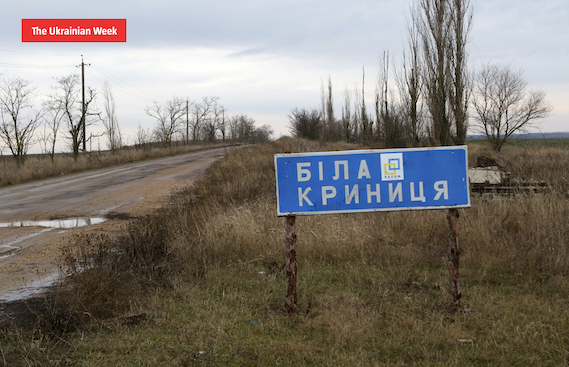
Photo: Roman Malko
When Artem’s father and I travelled from Lviv to Mykolaiv Oblast, only two and a half months had passed after that fatal event. The front line was still not far from where the boys had perished, near the Ingulets River on the border of the Mykolaiv and Kherson regions, and reaching there seemed almost unreal. No one was willing to allow civilians through, and escorting civilians to a ‘zero line’ [a term used in Ukraine to describe the nearest point of contact with the Russian occupation forces –ed.], where combat operations were ongoing, was practically out of the question. Moreover, with the Ukrainian army gearing up for a counteroffensive toward Kherson, the situation grew increasingly intense, with everything seeming more uncertain and hazy. Nonetheless, Father Mykhailo found tremendous inspiration in this mission. He somehow acquired a metal detector, hoping to locate his son’s phone buried under debris from the explosion.
That’s when we resolved to give it a shot. In times of war, there’s no room for delaying action until tomorrow, as tomorrow may never arrive.
At that time, we didn’t make it to Bila Krynytsia, but we were lucky to meet Artem’s comrades, the ones who fought by his side. They warmly welcomed us at their base in Mykolaiv, sharing everything they knew. They assured us that once Kherson was liberated, it would be safer to visit those places. They even offered to take us to the spots where ‘Kurka’ and ‘Istoryk’ lost their lives.
At that point, there was already a lot to absorb. “I viewed the journey to the Mykolaiv region as a personal mission,” Father Mykhailo later recalled. “I aimed to get as near as I could to the front lines, to the very spot where my son Artem had fallen. Though we couldn’t reach the precise location where he was fatally wounded due to ongoing combat, we met numerous of his fellow soldiers, engaged in conversations with them, and gained a wealth of information and understanding.”
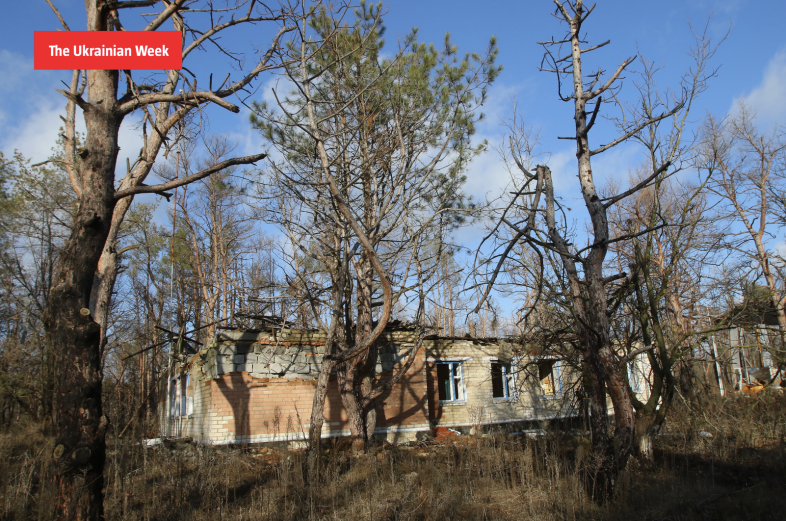
Photo: Roman Malko
It wasn’t until sixteen months later, in early 2024, that the father finally made it to the place where his son perished in Bila Krynytsia. Kherson had been liberated for some time, and the front line had moved beyond the Dnipro River, but previous attempts to reach this spot had failed—something always seemed to intervene. This time, the priest wouldn’t be travelling alone. His wife, Ivankа Krypyakevych-Dymyd—Artem’s mother, a well-known artist and iconographer from Lviv—would accompany him, along with Artem’s sister, Magdalyna. The comrades of ‘Kurka’, the ones he fought alongside, would also be there. They were the ones who orchestrated this unusual journey for the family of their fallen friend, understanding just how crucial it was for them.
Logistics in Ukraine were disrupted due to the Russian invasion, so they started their journey from Lviv by train to Odesa. From there, the boys drove Artem’s family by car to Mykolaiv and then to Bila Krynytsia. “I was apprehensive about this trip,” Artem’s mother shared on her social media page. “It was planned five times, and each time, I hesitated, afraid I wouldn’t be able to bear it. But now, I feel a solemn sense of purpose. The hangar where my son slept in the middle of a field on straw bedding with his comrades has become a sacred place for me. The impact from the mine explosion is like an altar…”.
“This hangar is where we first showed up to meet with the mortar teams,” remembers Roman Lozynsky, a friend of Artem’s and a current member of the Ukrainian Parliament. “The older guys, after sizing us up and hearing about our mission, just smiled and said, ‘Boys, we wish you success.'”
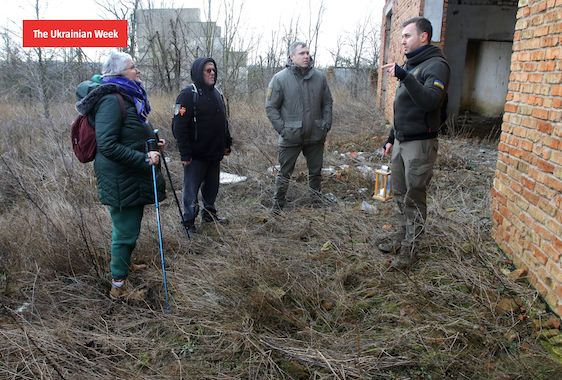
Their task was to figure out the optimal way to cross over to the opposite bank of the Ingulets River and prepare the area for the advancement of the Ukrainian assault forces. To make our way towards Kherson and free up the right bank of the Kherson region, we needed to establish a stronger presence on that side. “In fact, our unit of special operations forces was among the first to carry out operations in this sector, with the goal of crossing to the other side of the river,” Lozynsky explains.
Describing the guys’ work as remarkable would be an understatement. It wasn’t just about the constant raids across enemy lines to complete specific missions. During that time, this frontline could have been the hottest spot on the planet. Soldiers later stationed in the Bahmut direction reported that the artillery here was far more intense than anywhere else. The Russians didn’t hold back on ammunition—they fired from all calibres. The entire Ukrainian push to that side faced an onslaught of relentless fire.
“Back then, we didn’t have kamikaze drones, and FPV technology wasn’t a thing. It was just artillery,” Lozynsky recalls.
“Shells were raining down every couple of minutes. It might be a mortar round, an artillery shell, or at certain times, a tank would roll out, and open fire or a helicopter would unleash unguided rockets. The barrage was constant. When you’re under fire every few minutes, it becomes the norm, and you start to tune it out.”
It was during this relentless bombardment that a 120mm mortar round struck, tearing Pavlo apart and fatally injuring Artem. The comrades nearby in the hangar were jolted to attention by a chilling scream, cutting through the monotonous thuds of explosions.
Artem’s parents are intimately familiar with every detail of the story, one they’ve lived through, reflected on, and shed tears over countless times. Yet, being at the actual site, seeing it, touching it—holds an entirely different significance. “I was quite apprehensive about how I would react,” Ivanka admits, “fearing a sense of despair or something of that sort…” However, her fears didn’t materialise. “I see remarkable, resilient individuals fighting here; I witness local residents aiding the army.” Roman shared stories of the men who brought gravel on ‘Kamaz’ trucks amid the shelling, constructing a passage for our soldiers across the Ingulets. It’s a mix of profound emotions. A sense of sanctuary, of peace, of inner serenity. And the overwhelming gratitude and sanctity of this place. It has become a sacred spot for our family. Bila Krynytsia holds that sacredness now.”
“I’m feeling remarkably optimistic at this moment despite arriving here in a state of deep melancholy. I was worried I might crumble right there, but I feel uplifted, almost reverent, now.”
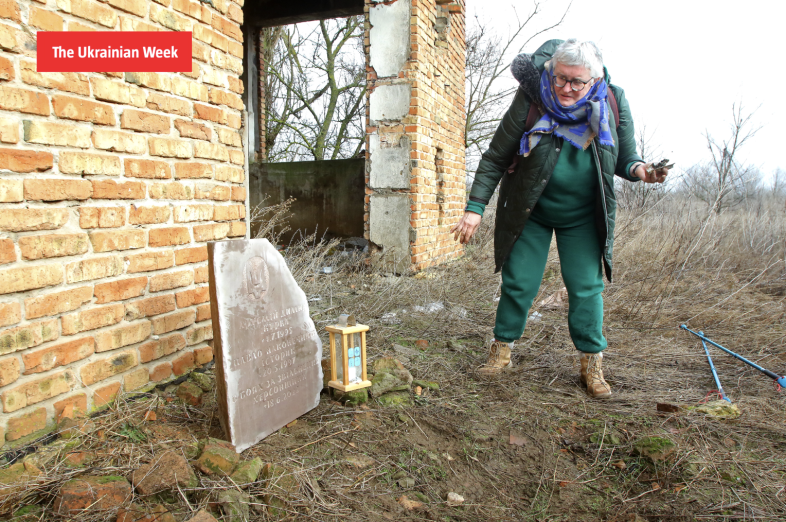
Photo: Roman Malko
Father Mykhailo didn’t bring the metal detector with him this time to search for his son’s phone. Instead, the family brought a huge 70-kilogram stone from Lviv to the edge of Mykolaiv Oblast, engraved with the names of the fallen boys. “Mykhailo came up with this idea on Saturday,” says Ivanka, “and the sculptor worked on the stone on Sunday and Monday.” They placed it at the edge of the cliff under the wall of the shattered hangar. As soon as they set it up, a bright southern sun appeared in the leaden winter sky. It was a deeply moving sight. The father conducted a memorial service for his son and his comrade, the sound of “Eternal Memory” echoing across the steppe while the sun shone as if trying to heal all the terrible wounds inflicted by the war. “We cherished every morning,” recalls Roman Lozynsky, “the sun rises and your mood shifts. You could be facing death, and then there’s this sun.”
After exploring the wreckage of the hangar, the parents ventured to the village and the children’s camp nestled in the nearby forest, where the boys had stayed during their work here. While the village, despite its destruction, still displayed occasional signs of life—people glimpsed mending their homes, smoke rising from chimneys—the camp remained desolate. Collapsed cottages, a shattered pool, charred trees… The boys recalled that upon their initial arrival, everything had been fresh and intact, but once the enemy targeted the other side of the river, it all changed.
“There might be plenty of unexploded objects under our feet here,” Roman cautioned. “The enemy remotely mined this area. So let’s proceed cautiously, sticking to the asphalt, please. We’ve got the turnstiles with us. Just be sure we’re not overlapping them now.”
The forest-hidden camp acted as the primary stronghold for the Ukrainian defenders. Being well aware of its location, the enemy subjected it to frequent bombardment. Roman vividly recalls their initial arrival, witnessing soldiers from another unit digging trenches near a sizable outdoor pool. However, their respite was short-lived as a shell soon found its mark in the pool’s waters.
“First thing we did within the first couple of hours was evacuate two wounded from here,” Roman recounts. As they settled into their temporary quarters – the camp, a helicopter swooped in, raining shells upon them. “We heard this peculiar sound, like a cell phone vibrating, and moments later, the rockets came whizzing down. That vibration signalled the approaching helicopter, barely audible at first. We scrambled for cover as the rockets flew, and then the shelling intensified from multiple directions. And ‘Kurka,’ he’s an absolute genius. Right then and there, he calculated exactly which house they’d hunker down in, from which angle, on which balcony. ‘Ah, they’re firing from over there, at this angle, these windows face this way, and this house offers cover like that, so I’ll be here and from that side.'”
“It’s such a shame about the trees,” laments Artem’s mother, surveying the surroundings. “Almost all of them have been burnt. There used to be such a beautiful pine grove here. Trees without their tops. And that’s symbolic, too. A tree without its crown is a symbol of a young person who perished too soon, unable to fully blossom into their beauty. Unable to reach the full bloom of their talent.”
“I learned today that the battle for Mykolaiv was incredibly significant at the start of the full-scale war,” the woman continues. “If the Russians had broken through Mykolaiv and Kherson to reach Odesa, Ukraine would have fallen. The threat from the south was immense. And in essence, our son died so that this land could flourish, so that the whole of Ukraine could flourish.”
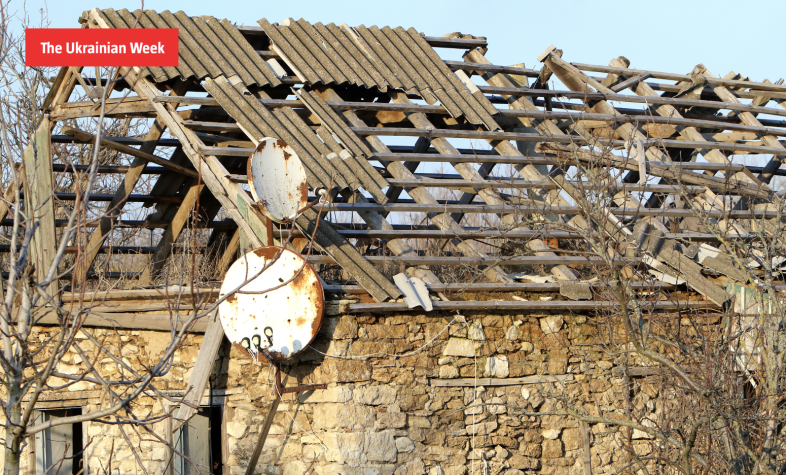
Photo: Roman Malko
As we finally made our way to the cars bound for Mykolaiv, I turned to Father Mykhailo to hear his thoughts. “Now that you’ve finally reached the place you’ve longed for so much, what are your feelings?” I ask.
“This is the very spot where Artemko [an affectionate nickname for Artem – ed.] made the ultimate sacrifice for his family, friends, and Motherland. Instead of adding to our pain, it becomes a place of pilgrimage,” the priest reflects.
“As I drove here, I realised that I was tracing the path that my Artem and countless other warriors took to defend Mykolaiv Oblast, Kherson Oblast from the Moscow enemy. I thought to myself—this is the path of heroes. A path walked by both the living and those who have passed into eternity. And I’m grateful that I can tread this path. It fills me with inspiration. It also brings a deep ache. I feel immense pain, yet alongside it, I hold onto great hope. It’s the perspective that this sacrifice, as absurd as every war is, binds together those who stand united to defend their values, their families, their Motherland.”

